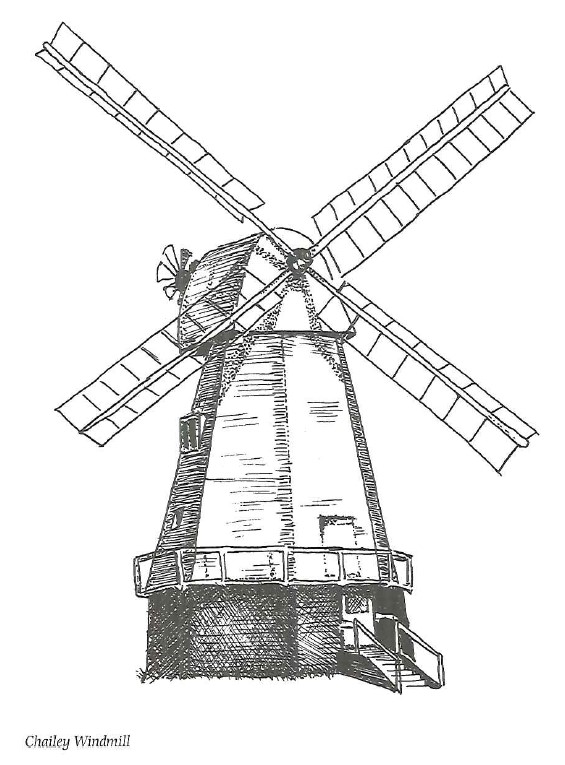The Tiger Inn, eye-catcher of the oldest part of the village which lies on the seaward side of the Eastbourne road, probably got its name by error. It was taken from the Bardolf coat of arms which depicts a leopard. This could have been an understandable mistake 400 years ago when a simple innkeeper would never have seen either beast.
There are fire marks above the doors of two cottages next to the shop. These were the emblem of the insurance company and the policy number so the company’s fire fighters could tell at a glance whether a blazing house was insured with them. Presumably if it was not they left it to burn!
The bow-fronted house called Dipperies was built by James Dippery on ill-gotten gains. This 18th century gentleman Smuggler amassed a fortune from his illicit trading until one day he was caught red-handed by the Excise men and sent with his cronies for trial. Dippery turned King’s evidence, was instrumental in sending his old confederates to Botany Bay for the rest of their natural lives and then settled down a free man to build his house and make the most of the loot.
If the sea played its part in making men like Mr Dippery rich it was also the downfall of many mariners on the treacherous coastline just south of East Dean, which had an appalling record of shipwrecks.
Parson Jonathan Darby, vicar here from 1715 to 1728, hollowed out a room in the face of the cliff at Belle Tout, well above the high-tide line, and constructed a sloping tunnel and steps to lead up to it from the beach. He would shine a light from his cavern out to sea on stormy nights and wait for any sailors struggling to make their way up to his sanctuary. “Parson Darby’s Hole’ disappeared because of coast erosion at about the same time as the Belle Tout lighthouse went up in 1831.
Beachcombing for the cargoes of the wrecks must have been a profitable pastime for the village and a 16th century document indicates that a court of inquiry was held to establish what each man had taken when a ship laden with wine came to grief on the parish foreshore.
Still standing in the village is the first cable office connecting Britain with the continent. Its wires were carried on telegraph poles over the Downs to connect with the under-sea cable at Birling Gap. At Hope Gap can be found the remains of a hushhush three-way wartime connection – the cable that linked Washington’s White House with Churchill’s War Room and the distant Kremlin in Moscow.
The church registers tell the eerie story of Agnes and Joan Payne, who were buried here in 1796. Agnes was taken ill and lay speechless for 24 hours before suddenly crying out to her sister to make ready to come, as she could not go without her. Joan was in good health but within half-an-hour she too became ill, growing worse overnight as Agnes continued to call for her to come. The two sisters died together in the morning. The story’s accuracy was Vouched for by the vicar and three churchwardens.
Birling Manor was the home of the Gurneys and when Juliana Gurney married William Bardolf in 1257 the house was probably part of her marriage portion. A decade later William Bardolf was granted a licence from the King to hold a weekly market and an annual fair at East Dean. The fair, held on the feast day of St Simon and St Jude, patron saints of the parish church, continued until the dawn of the 20th century.
The Bardolf family may have had the knack of marrying rich young heiresses but also the fatal flaw of backing the wrong side. Hugh Bardolf, son of William and Juliana, was adviser to the ill-fated King John and Lord Thomas Bardolf (who appears in Shakespeare’s Henry IV) took part in the Earl of Northumberland’s revolt against Henry IV, was wounded in battle and died soon afterwards. In 1406 he was posthumously dishonoured in Parliament and his lands forfeited to the Crown.
Birling was later granted back to the family, only to be finally lost in 1461 because Lord William Bardolf fought for the Lancastrians against Edward IV.
A branch of a family that had better luck with royalty lived at Pendrills, the village’s old laundry where the washing was once hung out on the hill behind to dry. It was the home of the descendants of the Pendrell brothers who hid Charles II in the oak tree at Boscobel and were richly rewarded at the Reformation when the King granted the family a pension of £100 a year in perpetuity.
